|
 Dwight Peck's personal website Dwight Peck's personal website
Scenes of Bologna, 2014
The venerable city of porticos, towers, and canals in the springtime
Kristin's come up from Rome, I've come south from Switzerland, and we're dashing all round Bologna's city streets, anxious not to miss a thing. 28-29 May 2014.
    
You may not find this terribly rewarding unless you're included here, so this is a good time for casual and random browsers to turn back before they get too caught up in the sweep and majesty of the proceedings andcan't let go.

Back from Modena in good time, to a rainy Bologna train station

The Piazza 20 Settembre

The site of Bologna was occupied by the Villanovan Iron Age culture from the 9th century BC, but the Etruscans crept north and superseded the Italic Umbrians -- it was they who developed the settlement, under the name Felsina, from the 7th century BC onwards. [The city history museum has marvelous displays of the archaeology of this era.]

Lo, in the 4th century BC the Po valley was invaded by Celts from Transalpine Gaul, chiefly (around Bologna) a tribe called the Boii, who assimilated with the Etruscan population and dominated much of northern Italy until the Roman Republic subjugated them in 225 BC. Temporarily . . . because when Hannibal came over the Alps in 218 BC, the locals joined up and provided military support to the Carthaginians roaming round Italy for the next 15 years, unable to capture Rome and eventually giving it up as a bad job.

Giuseppe Garibaldi and his favorite horse, Bronzie
In the Roman clean-up after Hannibal's defeat at Zama, they came back and in 196 sorted the Celts out properly, then made "Bononia" a Roman colonia and started shipping settlers north. The military road of the Via Aemilia was built through the area in 187 BC and turned the city into a flourishing trading centre.

The parallel lines are a bicycle lane across the piazza. An elegant lady in a business suit just blasted through here at 35 kph.

Puzzling. A crusading knight called "Il Moro". Or was his real name "Sir Self Service"? ("Il Moro" was the nickname of Ludovico Sforza, Duke of Milan, two centuries after the Crusades.)

Bologna's street plan was basically laid out in the first century BC, with the normal Roman rectilinear thoroughfares of decumani and cardi, and the city flourished as one of the most important cities in the Roman Empire. Subsequently, like other cities in northern Italy, it was taken over by Odoacar's Ostrogoths in the late 5th century, Theodoric's Gothic kingdom in the early 6th, the Byzantine reconquista in Emperor Justinian's "Gothic War", then the Lombard occupation from 568 to the late 8th century, and then by Charlemagne in AD 774. Who gave it to the pope.

Later, Bologna achieved free commune status in the early 12th century (with Countess Matilda's help) and flourished with its canal system facilitating trade relations for its burgeoning textile industry. At its peak the city had some 50,000 residents, said to have been the 5th largest city in Europe at the time.

The bird painter has been here.

Thereafter, like most northern Italian cities, Bologna got bounced all around amongst Guelph and Ghibelline factions, papal forces and Visconti Milanese, until in the early 15th century the Bentivoglio family prevailed in city politics and oversaw a century of Renaissance splendor.
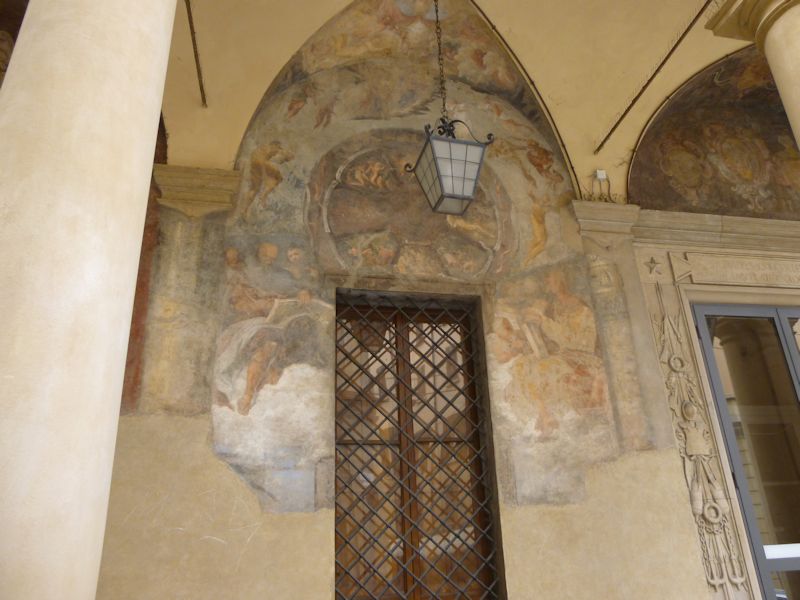
The glorious 15th century renaissance came to an abrupt papal end when Pope Julius II's mercenary army besieged the city in 1501, stole the art treasures, and absorbed Bologna into the Papal States, where it lumbered along for a long time awaiting Napoleon.

We're wandering round near the Tagliavini musical museum (closed at the moment) and going along to the Via Manzoni.

The Chiesa della Madonna di Galliera (Oratorio of San Filippo Neri), on the Via Manzoni, closed. "Nearly destroyed by Allied bombs, reconstructed using old photographs". How often have we seen that in Italy?

Since we're traversing the neighborhood, we pop back into the disappointing Duomo. Yuck.

But this is fun, a fascinating terracotta group by Alfonso Lombardi of Ferrara, early 16th century, called the Lamentation of Christ. But moving on . . .
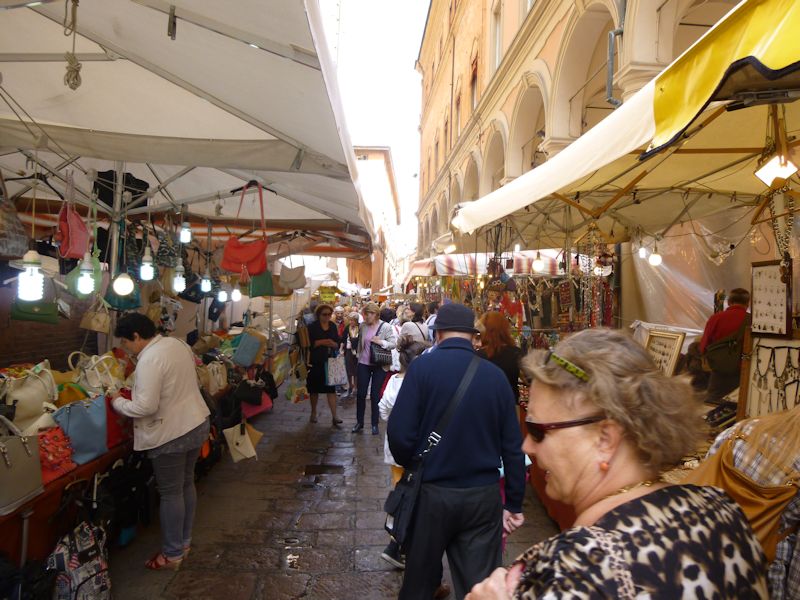
. . . there's a street market next door in the Via Altabella, and we're on the hunt for various items.
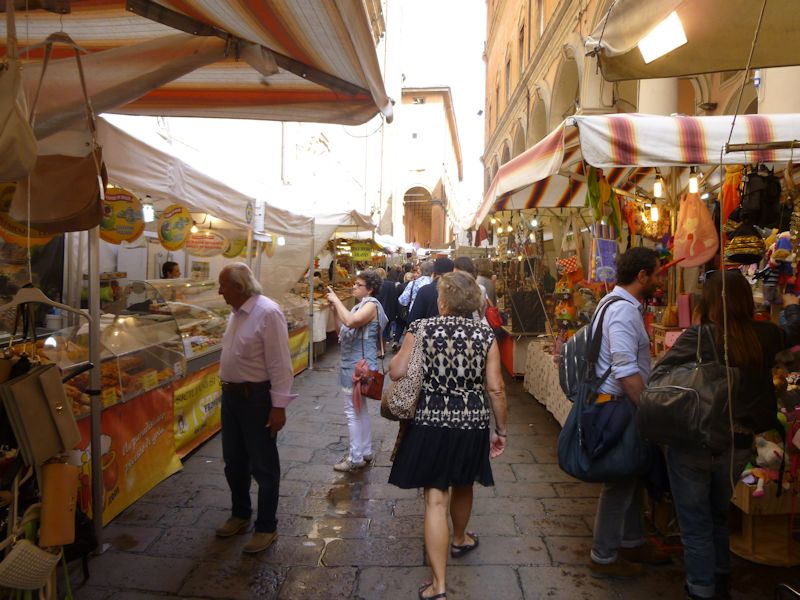
I'm not sure what we're looking for, but that's okay because we've got an expert with us.
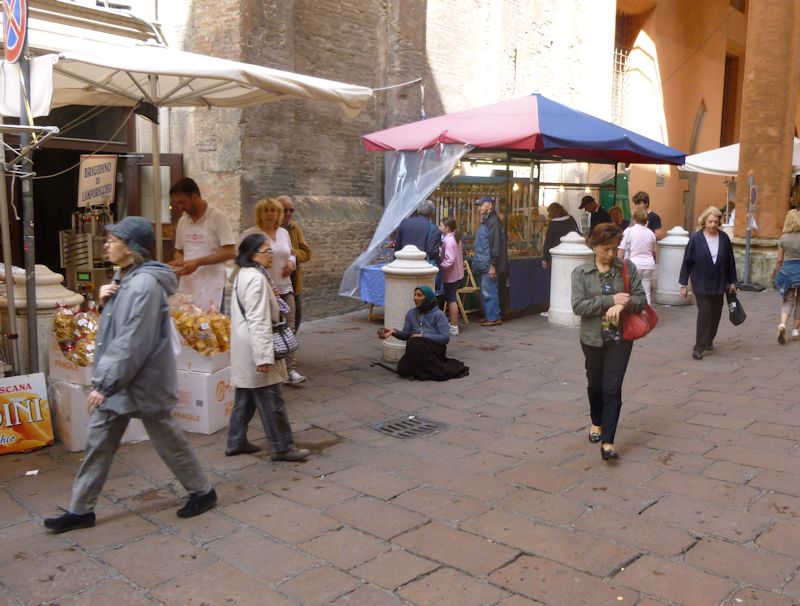
Amidst the buying and selling alongside the Cathedral, one of life's victims seeks assistance and moans piteously from time to time. Except when her friends drop by to take a break and chat.

-- We can meet ALL of your piety needs right here.

Street market scene

Another civic tower up the alley. The Torre Prendiparte . . .

. . . otherwise known as the "Happy Tower".

Oh look where we've fetched up again. The shorter but more leaninger tower, called the Garisenda, is mentioned by Dante in the Inferno (publ. 1317), so that can't be blamed on our WW2 bombers.

Leaning tower scene

The Due Torri, defying geometry

We're on CCTV.

And home by way of the Piazza Maggiore
Now it's another day.
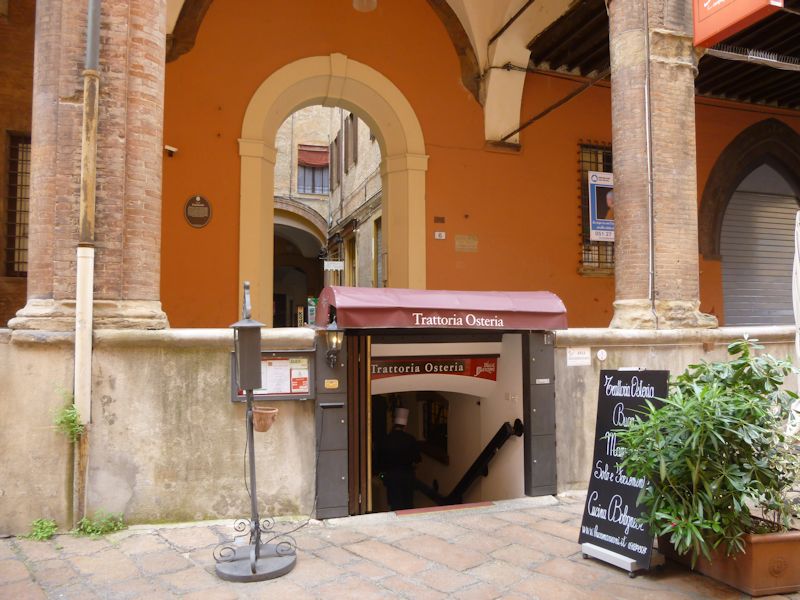
We'll be a minute here, on the Via Manzoni. Kristin's inside making a reservation at the Buca Manzoni ("cucina tradizionale"). Now we're on our way to see the musical stuff.

The Via Parigi -- we're looking for the San Colombano church and the "Collezione Tagliavini di Strumenti Musicali", somewhere round here.

Bingo. (Ecco.)

Fabulous old harpsichordish instruments. The church of St Colombano dates from the early 7th century but was bounced around over the epochs by various religious orders, until Napoleon closed them all down. In 2005 it was purchased by a foundation and restored, and here we are.

This (we are told) is a 'Rectangular Spinet (Spinetta) of the Neapolitan Type' (1598).

Very nice, probably old. Madonna/Child, John the Baptist, and presumably St Colombano
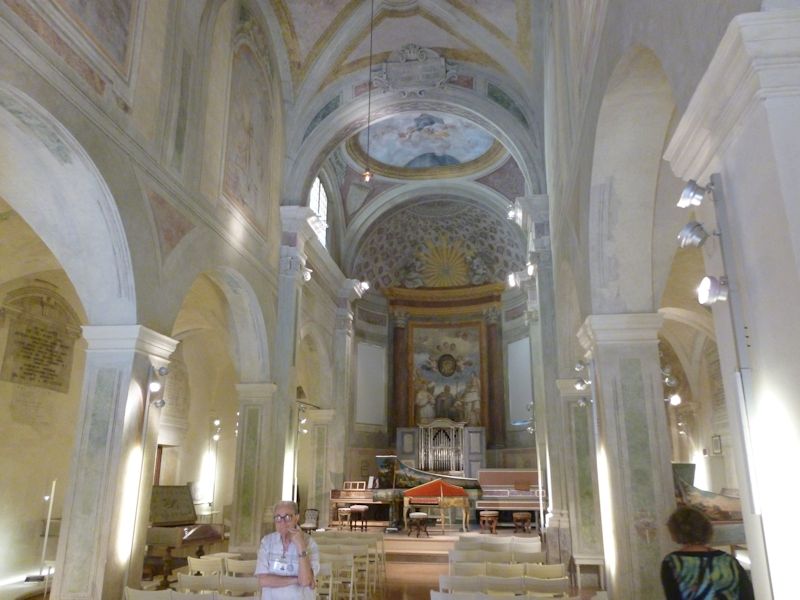
The nave of San Colombano, now a musical museum with medieval frescos on it

Now that's a Spinetta Traversa, or 'Bentside Spinet' (1754)

This is from a kinder, gentler age (for the rich folks).

And here, up in the Chapel of Our Lady of Prayer (1591) with its Carracci school frescoes, is a genuine Clavicembalo All'Ottava, or Octave Harpsichord, ca. 1730.

And here, down in the crypt, is Kristin.

The fresco in the crypt, discovered during renovations, is said to be part of the "crucial transitional decades from Byzantine style to the advent of Cimabue and Giotto", but there's not a lot left of it.

This, up in the Oratory of San Colombano with its fabulous frescoes, is an "Octave Spinet" (1617).

And this is a Pentagonal Spinet, they say. We're high above the San Colombano nave just now, and about to pass out along the balcony to . . .

. . . here. The professor is delivering a lecture on the assembled ancient instruments to a small but rapt audience.
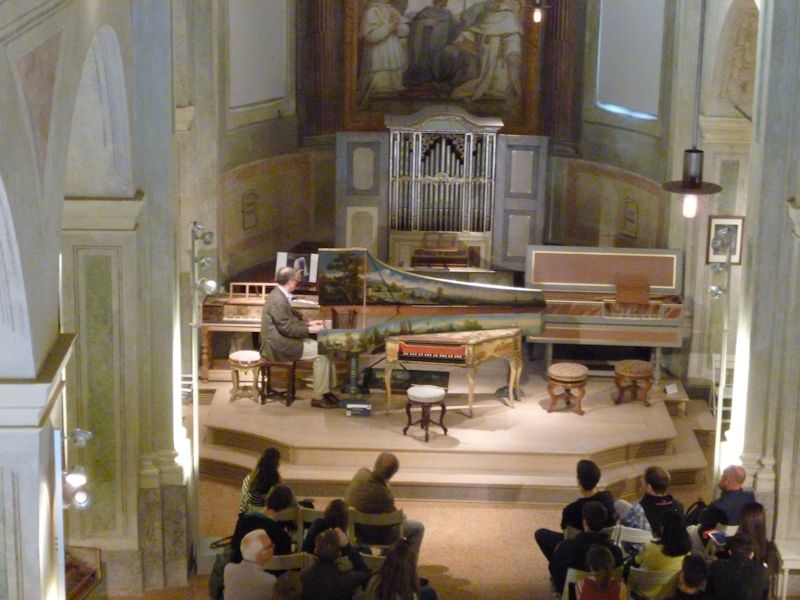
The professor is demonstrating his point on one of the beautiful instruments of a bygone day.

With suitable explanations, the professor now illustrates his next point on another one.

A brief pause whilst the professor takes a call from his wife ('pick up some milk and cat food') . . .

. . . and he resumes.

Now we've come to the . . . well, as in the photo. In the Via Manzoni.

The courtyard of the Medieval Museum

They've got everything here -- even medieval shoes that make you two feet taller.

-- I can't be sure, officer, but number 2 on the left looks like the guy.

There was a tradition in Bologna's medieval period to celebrate ex-professors in the famous University with expensive funeral monuments, commemorating their academic and pedagogical triumphs, and it seems weird, but that fellow in the centre is a dead ringer, in attitude and expression, for a student I had in Ohio. I had to give him a "C-".

-- What you looking at, boy?!

-- Beam me up.
(Pope Boniface VIII, Dante's nemesis)

The medieval museum is an endless fascination.
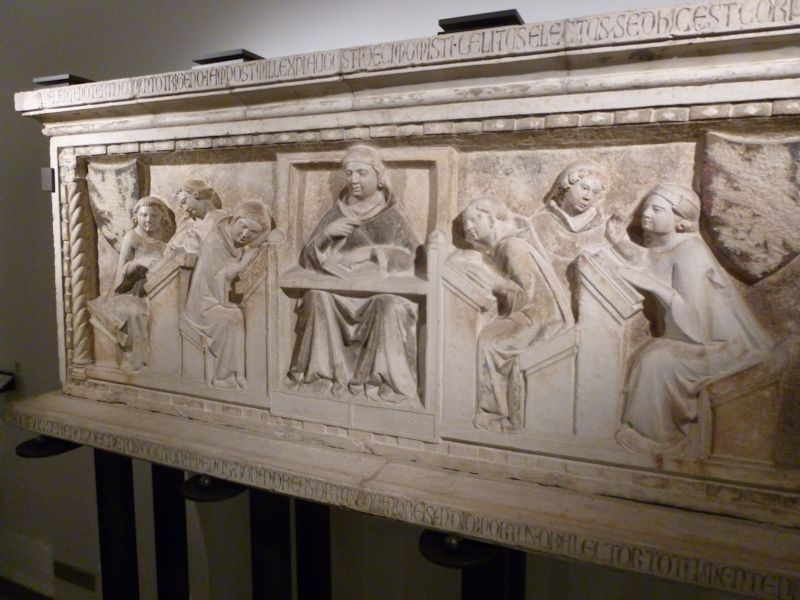
More professors commemorated, along with their favorite students having a snooze. Amongst the illustrious students at the university here were Dante Alighieri, Giovanni Boccaccio, and Francesco Petrarch.

-- There'll be a quiz on Friday, at the usual time. For credit.

-- The most important thing to know is that you know nothing. You never will. Now, let's get started.

Some doctors of the church and university, when their time came, did not go gracefully.

-- I'm ready. I crave Knowledge. Let's Roll!

The hall of funeral slabs (one of them)

Even bishops and archbishops need to behave themselves. (Catch that, Cardinal Law?)

There's a beautiful display of medieval music books as well.

I have a modest interest in medieval and Renaissance-era weapons and armor, and this place has a ton of it. Charitably, I'll spare you the other 76 photographs.
Where's Kristin's gone?

-- Medieval weapons, was it? Ennh.

The courtyard again of the Medieval Museum

We're back at the Philip Neri across the street -- still closed! How are they going to compete with all these new religions if they keep all the good stuff locked up?

Kristin contemplating something, probably dinner.
    

 Feedback
and suggestions are welcome if positive, resented if negative, Feedback
and suggestions are welcome if positive, resented if negative,  .
All rights reserved, all wrongs avenged. Posted 5 July 2014. .
All rights reserved, all wrongs avenged. Posted 5 July 2014.
|
 Dwight Peck's personal website
Dwight Peck's personal website 



































































